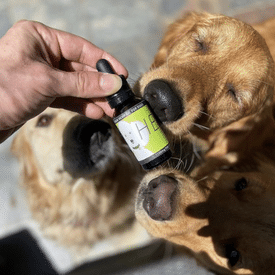Hip Dysplasia: CBD Success Stories

We know our dogs have the time of their life running around, jumping, fetching, playing with other dogs. That’s why hip dysplasia in dogs can be so scary. Oftentimes by the time they are taken to the veterinarian, it’s usually because their activity level has already significantly decreased, they struggle to jump on the couch or run around like they used to, which is a worry for their quality of life. The good news is that there’s a lot we can do to make our dogs comfortable and ensure they still have a great quality of life.
Table of Contents
What is Hip Dysplasia in Dogs?
In order to fully understand the detrimental effects of hip dysplasia (also referred to as Developmental Dysplasia of the Hip or DDH) and weighing out the available options, it’s important to understand what hip dysplasia actually is.
Dysplasia is derived from Greek words meaning “bad formation.” Basically, that’s the description in a nutshell. Bad formation.
This isn’t usually immediately seen. Dogs instinctively hide pain, so they aren’t likely to show it until it’s to the point where they are struggling. Once a dog is showing the pain more obviously, the cartilage has typically already been worn and the muscles have been strained. In severe cases of hip dysplasia, dogs may experience decreased mobility, arthritis in their joints, and a degree of lameness generally in their hind end.
The Cause of Hip Dysplasia in Dogs
Hip dysplasia is genetic, it’s hereditary and for many dogs, it’s just a matter of age and time. Hip dysplasia is also more commonly found in larger breeds due to the speed of their growth and the effects of weight on their ball and socket. Not all dog breeds are prone to hip dysplasia, but those that are can experience a great deal of pain by the time they are showing their symptoms.
Recognizing the Signs of Hip Dysplasia in Dogs
If you aren’t sure if your dog has hip dysplasia, it’s best to consult with a holistic veterinarian to obtain a diagnosis, but the most common symptoms include the following:
- Activity levels slowing: Dogs with hip dysplasia who were once active may appear to be too tired to get up. You’ll likely notice a significant decrease in activity levels over time. Your dog might sleep more and have less of an urge to go fetch the stick or play her favorite ball game.
- The stairs are too much: This is one of the top complaints when a dog lover brings her dog into the veterinarian’s office. My dog can’t get up the stairs or stops walking halfway through the journey. The inflammation can cause a decreased range of motion in your dog’s ‘ball and socket.’ You may also notice your dog’s hesitation or lack of ability to jump into the car or jump onto your bed as well.
- Weakness in the back legs: Depending on how bad your dog has instinctively allowed hip dysplasia to become, you may notice her back legs giving out from under her. Over time, the wear and tear from the bones rubbing against one another may result in your dog’s ball and socket not working at all. This results in inflammation and pain and/or the inability to use one of her back legs.
- Trouble Getting Up: You may begin to notice your dog has lost the ‘pep in her step’ and now has trouble getting up on her own. It may take her a few extra moments or she could struggle for a significant duration of time depending on the severity of the condition.
Conventional Options: NSAIDs to Reduce Inflammation
Traditionally, a veterinarian would recommend NSAIDs to reduce painful inflammation, but these carry a wide range of side effects. For some dogs, the disadvantages of NSAIDs outweigh the advantages. Dogs who take conventional anti-inflammatory drugs may experience vomiting, lack of appetite, depression, stomach ulcers, diarrhea, kidney failure, and/or liver failure.
Alternative Options: Glucosamine, Chondroitin, and CBD For Hip Dysplasia in Dogs
Chondroitin and Glucosamine are excellent for assisting with inflammation, but unfortunately, we have yet to find a consistently reliable source we can recommend. All the supplements we have found thus far have not been high in purity and will therefore be less effective.
You may ask yourself, “Is CBD good for dogs with hip dysplasia?” The answer is yes! Full Spectrum CBD oil for dogs with hip dysplasia is a side-effect free, safe option for your dog.
Inflammation is the root cause for hundreds of issues. Any time you (or your pet) experience chronic pain, arthritis, allergies, anxiety, pancreatitis (or any diagnosis ending in “itis”), diabetes, autoimmune diseases, IBD, and other GI issues– it is inflammation that causes the symptoms to worsen, or even the cause of the issue itself. Full spectrum hemp extract (CBD) has been proven to shorten the duration and frequency of inflammation-related issues including hip dysplasia, arthritis and joint pain, seizures, pancreatitis, allergies, anxiety, diabetes, Cushing’s Disease and other autoimmune diseases.
Full Spectrum CBD is also great for reducing pain. Cannabis has been used as an effective analgesic dating back thousands of years. One of the ways it does this is actually by changing the way their central nervous system communicates the sensation of pain to our brains.
CBD ‘talks to’ specific receptors in a dog’s body to help reduce the inflammation caused by the wear and tear, and damage of the ball and socket joint (and other joints you may not be aware of being damaged). In CBD’s ‘talk’ with a dog’s body, the receptors, pain is also reduced significantly.
How Much CBD Should You Give a Dog With Hip Dysplasia?
The amount of Full Spectrum CBD for dogs with hip dysplasia depends on how difficult it is for your dog to get around and your dog’s pain level. Start with a daily 9-18mg of CBD for dogs with arthritis. For our Ease tincture, this is about 1-2mLs (1mL contains 9mg of CBD), a standard eye dropper full. Remember also that CBD remains in the bloodstream for about 6-8 hours. For this reason, we recommend splitting your daily dosage into 2-3 doses.
If you don’t notice a difference in one to two weeks, try increasing the dosage. You can increase by another 9-18 mg, until you see results. You’ll know you found the correct dose when you see your dog run faster, jump higher, and become puppy-like again.
If your dog’s optimal dose is higher than 35mg of CBD a day, you may want to consider our Heal tincture. This tincture has 37mg of CBD per 1mL. Instead of giving 4mLs of Ease to achieve 35mg of CBD, you would only give 1mL of Heal, daily.
Take Action Now
The sooner you take action, the more successful the outcome with be, and the less damage your dog inflicts on their joints. This is particularly true for large-breed dogs. Since they are more prone to hip dysplasia, it’s definitely a condition to watch for. Look for symptoms so you’re able to take action swiftly. We want to make sure we help as quickly as possible to allow our pups to live longer, happier, and healthier.
Related: Choosing CBD for Your Pet’s Ailment
Success Stories
Belle
Belle was always an active dog. Her owner, Sandra describes the now 12 year old shepherd, wolf hound as one who loves to run fast, play hard and hop around the fields behind their house.
Like many dogs, as Belle got into her senior years her pet parents started to notice some changes in her mobility. Her hips started to show signs of weakness and discomfort and after a few triggering events, she began to lose her mobility faster and faster.
Unfortunately, some breeds, no matter how well loved and cared for, can be prone to certain degenerative diseases. German shepherds, a breed from which Belle certainly takes some genetic heritage, are prone to issues with the hind quarters. Hip dysplasia in dogs is extremely common and often leads to a debilitating pain and loss of mobility.
After using numerous other hemp products before for her dogs, Sandra talks about some of the reasons she believes CBD Dog Health’s EASE and HEAL have worked so much better for her dogs. First of all, these products are all full-spectrum.
“I like the fact that it’s full spectrum, I get that. It’s like with whole foods versus a single vitamin. when you get the whole food you can think of it like a whole orchestra playing. But if you just take like vitamin C, it might just be like a certain section of the orchestra playing and it doesn’t sound as good when you really want the whole orchestra working together to create the best music. “
After just a short time using EASE and HEAL CBD oil for arthritis and hip dysplasia, Belle started loosening up and growing more comfortable doing some of the activities she used to love. She was able to walk further, play longer and enjoy her time with her sister Pups.
“The less pain she’s in, the more I can exercise her the more the muscles can kind of get a little stronger. So my goal for her was to try and increase a little bit of that muscle mass that we initially lost because of the slowness or the degenerative disease.”
Belle is now getting back to her normal self and feeling a pep in her step again, without the pain from inflammation and pain in her back legs.
“The only thing I wish is that, I would have had it a little bit earlier for Belle, you know? So as soon as symptoms started, I would have been able to start to help her because then I think it’s easier for the body to heal itself.”
Tater

Tater, an adorable Chihuahua, has two luxating patellas and hip dysplasia in both hips. To add to it, he also has arthritis. Tater was barely able to walk when he was brought in by his foster parents. The effects from his health were so severe he barely had an appetite.
The recommendation? Tater was provided with 1 mL of HEAL 1100 mg Full Spectrum Hemp Extract CBD for hip dysplasia once daily each morning.
When we asked the foster parents how he was doing, the update was sensational. Tater is now able to walk, AND RUN, without pain! His foster family added his appetite has increased and his arthritis has improved. Before the CBD for hip dysplasia was introduced, his quality of life was extremely low. He is now soaking up the simple, but BIG, joys in life, as he continues to take HEAL daily.
Miss Daisie

14 year old Black Lab, Miss Daisie, could barely use her back legs prior to starting CBD for hip dysplasia and pain. What was her recommendation? A full drop of HEAL in the morning and another full dropper at night. She was provided a heavier dose than average due the severity of her pain each day.
“She could barely use her back legs and was dragging them behind her – although she wanted to be part of the pack, she could barely keep up. She is given a dropper full of HEAL in the am and PM. Its a heavier dose but she was also suffering from a tumor and was in a lot of pain. Today she can run, play, and even jump on the couch.”
The success stories shared with us are critical to understanding how much CBD can change your dog’s life. From severe pain to the ability to willingly and happily play, run, and jump? We couldn’t be happier.
Do you have your own CBD Success Story after using our products? Submit your pet’s CBD Success Story here!















